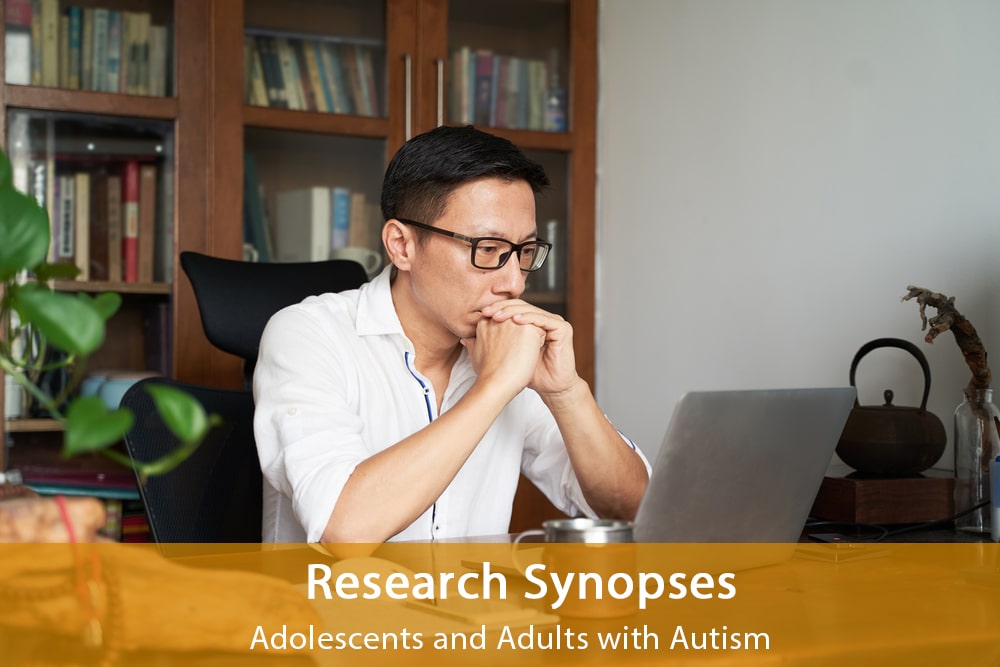
Wehman, P., Schall, C., McDonough, J., Kregel, J., Brooke, V., Molinelli, A., . . . Thiss, W. (2014). Competitive employment for youth with autism spectrum disorders: Early results from a randomized clinical trial. Journal of Autism and Developmental Disorders, 44(3), 487-500.
Reviewed by
Christopher R. Colasurdo, MA, Doctoral candidate
Caldwell University
Why review this topic?
 Individuals with autism spectrum disorder (ASD) often have difficulties obtaining and maintaining employment opportunities. The employment rate for adults with ASD ranges from 4.1%-11.8%, and these employment rates remain low regardless of the intellectual abilities and vocational skills of the individual with ASD. A variety of vocational rehabilitation programs are available around the country, and the demand for these services is increasing. Despite an increase in programs to support these individuals, the rehabilitation and employment rates for individuals with ASD remain low.
Individuals with autism spectrum disorder (ASD) often have difficulties obtaining and maintaining employment opportunities. The employment rate for adults with ASD ranges from 4.1%-11.8%, and these employment rates remain low regardless of the intellectual abilities and vocational skills of the individual with ASD. A variety of vocational rehabilitation programs are available around the country, and the demand for these services is increasing. Despite an increase in programs to support these individuals, the rehabilitation and employment rates for individuals with ASD remain low.
Although the need for evidence-based interventions to increase employment is clear, few studies have been conducted with adults with ASD. Project SEARCH is an intensive internship program used across the United States to help young adults with disabilities transition from school to work. Recently, a modified version of Project SEARCH has been used, adding ASD-specific supports. These supports include the use of applied behavior analytic techniques and specific social communication skills needed for success at work. The one study to research this modified Project SEARCH was a case study with only two participants. Thus, the need for replication with more participants is needed.
What did the researchers do?
Forty-four participants were randomly assigned to the treatment or control group during their last year of high school. The high-school students in the treatment group were enrolled in the modified Project SEARCH program, and the students in the control group received special education as directed by their IEPs. The authors hypothesized that those in the treatment group would be more successfully employed than those who did not receive the Project SEARCH program, both at the completion of the study and three months after. It was also hypothesized that the students in the Project SEARCH group would require less support in the work place. Data were collected through interviews and assessments.
The students receiving the modified Project SEARCH program were placed in a hospital setting during their final year of high school where they attended class and rotated through numerous internships in two different suburban hospitals. In addition to being taught job skills, the students were also taught social communication skills. Additional supports provided to meet the specific needs of young adults with ASD included: (a) onsite, intensive, systematic instruction using the principles of applied behavior analysis; (b) on-site support and consultation from a behavior/autism specialist; and (c) intensive staff training in ASD and the Project SEARCH Model. Additionally, each student worked with an interdisciplinary team comprising a special education teacher and assistant, two full-time employment specialists, and a business liaison. Individuals in the control group simply continued their final year of high school consistent with their IEPs.
What did the researchers find?
Results showed that 87.5% of the students in the Project SEARCH group were employed both immediately and 3 months after the conclusion of the study. In contrast, only 6.26% of the students in the control group were employed immediately and at 3 months. Students in the Project SEARCH group also showed increases in weekly hours worked and salary. Additionally, the Project SEARCH group students needed significantly fewer supports on the job sites. These students were working at a variety of different jobs, often ones considered to be difficult for individuals with ASD.
What are the strengths and limitations of the study?
This was the first study to use a rigorous research design to evaluate employment outcomes for individuals with ASD. Another strength of this study is that researchers incorporated a nationally recognized model with the addition of behavior analysis supports over the course of 9 months. They specialized the Project SEARCH model to be specific to individuals with ASD. The treatment also incorporated collaboration between professionals from many different fields. These professionals were well trained to both implement the treatment and collect data for supports specific for individuals with ASD. Students in the treatment group also received social and communication training and were given multiple opportunities to practice these skills. After the study, individuals in the treatment group worked at a variety of jobs, often those not associated with individuals with ASD and the wages earned were up to 24% above the minimum wage.
This study also has several limitations that should be addressed in future research. Some of the the outcomes in this study were based on self-report interviews, which can produce biased results. The researchers also only reported on indicators of treatment integrity, rather than actual measures. Thus, it is possible that the Project SEARCH program was not fully delivered as described. The researchers also did not interact with the control group and were, therefore, unable to analyze differences in the students’ IEPs. This makes it difficult to generalize conclusions about the low employment rate from the control group to other high school students with ASD receiving special education. Another limitation is that the Project SEARCH program required additional outside support and funding, potentially making it difficult to use in many schools and areas. Lastly, because this study was conducted at two different job sites within the same geographic area, it is unknown whether certain characteristics of the staff or this area had any specific effect on the results of this study. These factors make it difficult to generalize the results to other students with ASD.
What do the results mean?
The results provide strong preliminary evidence that Project SEARCH plus specific behavioral supports helps increase post-graduation employment rates for individuals with ASD. Those in the treatment group saw significant increases in employment and decreases in support needed when compared to the control group. Results showed that it is possible for individuals with ASD to obtain and maintain employment opportunities if provided with the appropriate teaching procedures and support. Anecdotally, the families involved in this study were extremely happy with the outcomes, and the students showed competence in the workplace. Further research should be conducted to determine whether such an intensive program is needed to facilitate competence in the workplace and future employment rates, and whether this program can be readily replicated in other locations and businesses.
Citation for this article:
Colasurdo, C. R. (2019). Research synopsis: Competitive employment for youth with autism spectrum disorders. Science in Autism Treatment, 16(3).

